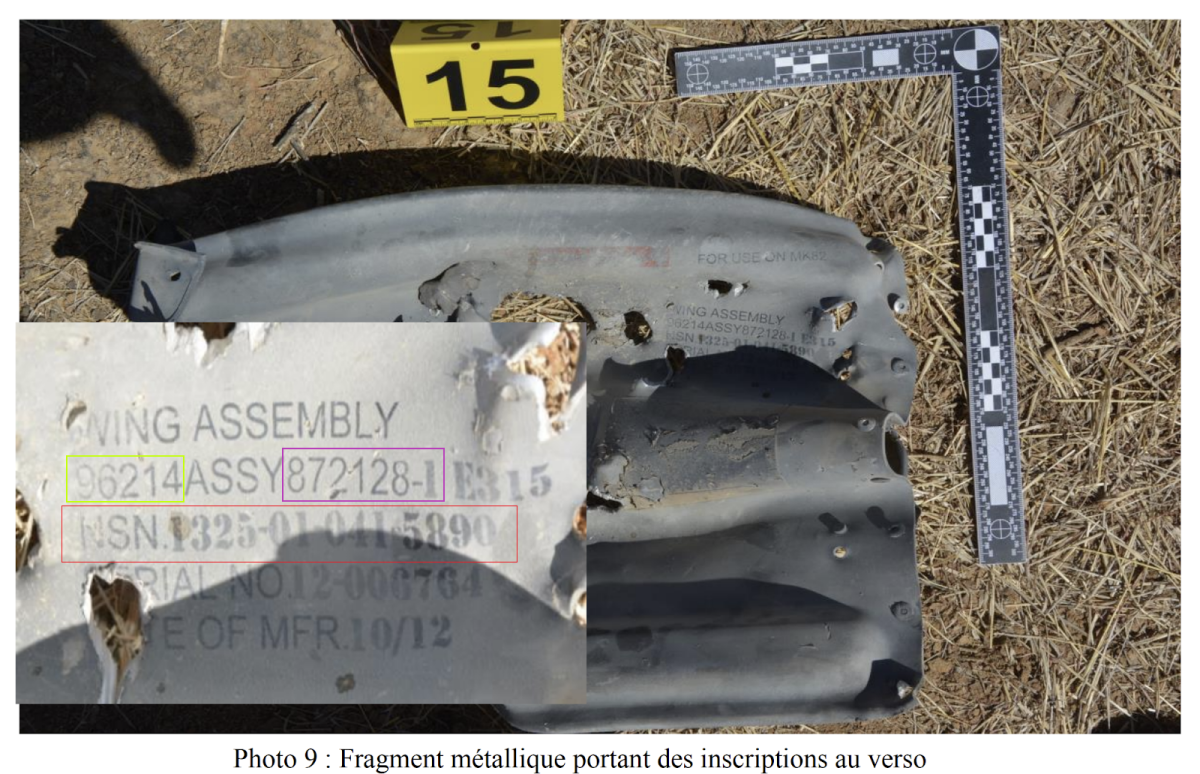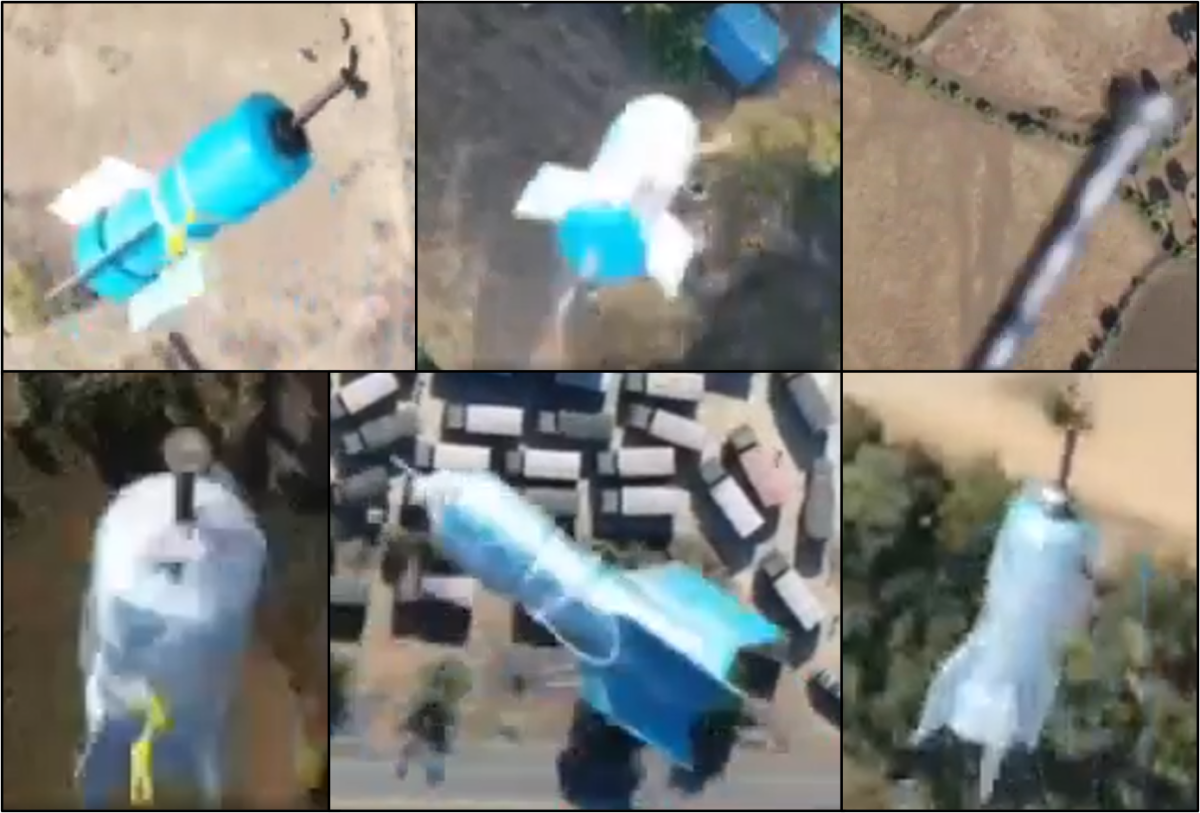Death From Above: The Drone Bombs of the Caliphate
(The Conflict Armaments Research (CAR) Group, an NGO working on the ground documenting weapons and ammunition, have confirmed that the plastic tail fins mentioned in this article are in fact moulded. CAR’s findings can be read in this comprehensive paper on multi-purpose IEDs.)
Introduction
The conflicts in Syria and Iraq have seen a proliferation of drones throughout the battlespace. Whether used for filming propaganda, as an intelligence, surveillance, target acquisition and reconnaissance (ISTAR) asset, or for command and control, drones are being used by a multitude of groups for a wide variety of missions. The Mosul offensive has seen this kind of drone warfare step up a level, with Islamic State (IS) employing drones armed with an assortment of different munitions, sometimes in conjunction with other assets, to deadly effect.
Armed unmanned aerial vehicles (UAVs) have been around for some time, probably the most famous being the V1 flying bombs used by Germany during the Second World War. Modern drones, such as the Predator, have been armed since 2001. Developments in civilian recreational drones, most notably multi-rotor, in the last five years have made them affordable, reliable and widely available. The parallel development and miniaturisation of civilian cameras and smartphones have turned these recreational vehicles into effective ISTAR platforms, and recently, weapon platforms.
IS is certainly not the first group to use drones as an offensive weapon. This video reportedly shows Jund al Aqsa using a drone to drop some kind of improvised bomb on Syrian government soldiers in September 2016. Another video from August 2016 appears to show a Hezbollah-owned drone dropping MZD-2 sub-munitions. Hezbollah has claimed to have this kind of capability since September 2014, and was an early adopter of suicide drones, using them during the 2006 Lebanon War.
However, IS are the first to use improvised attack drones on such a scale and, as we will see, appear to be modifying existing ammunition natures on a significant scale specifically for drone warfare.
Drone modifications
IS appears to use a variety of different drones and release mechanisms, ranging from dual under-wing release to simple cup holders. Basic plastic tubes have been seen underneath captured quadcopters, and appear to be roughly the right size for 40mm grenades, although the exact release mechanism is not immediately apparent.
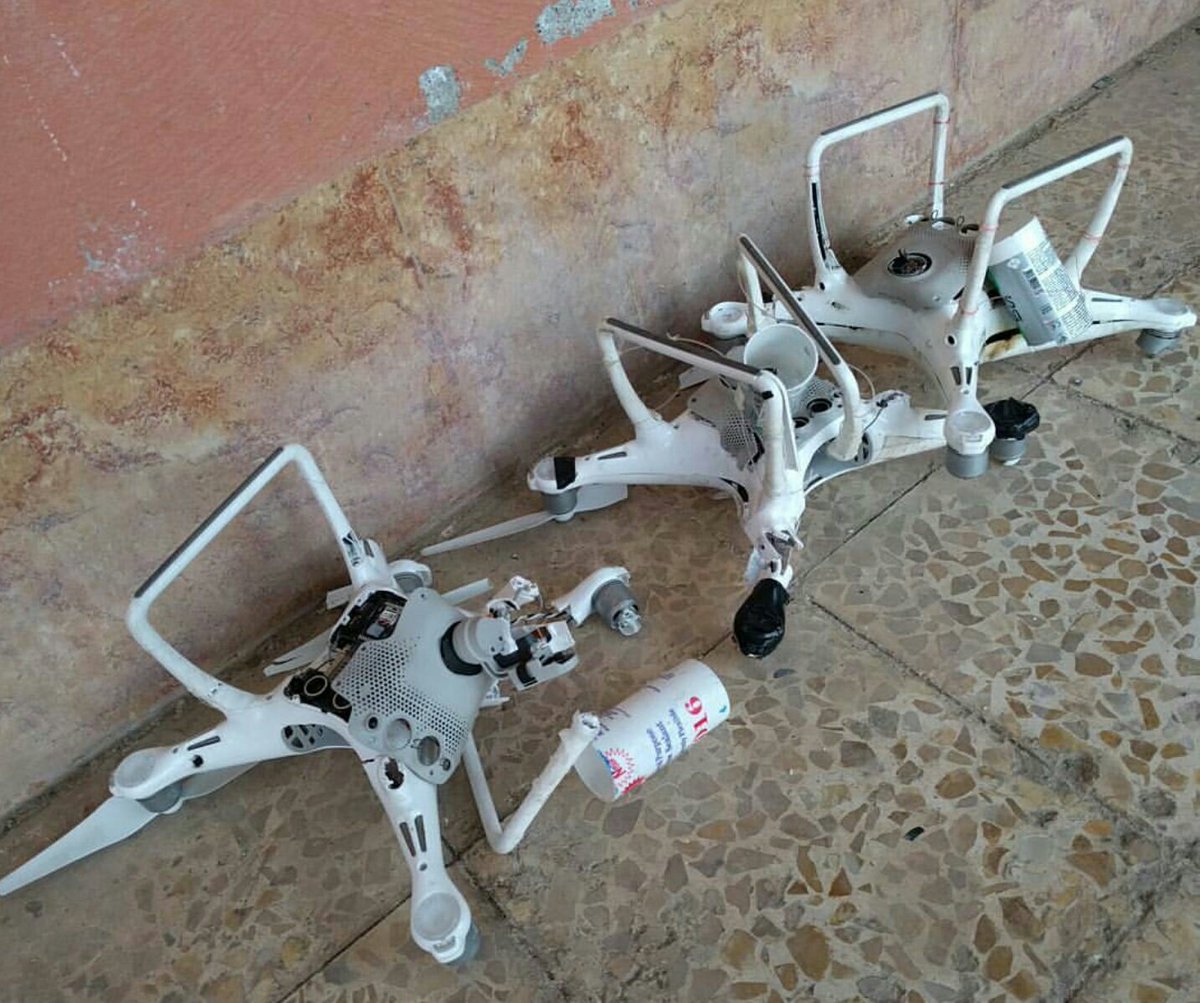
Basic cup holding mechanism on partially disassembled drones (Credit: Mitch Utterback)
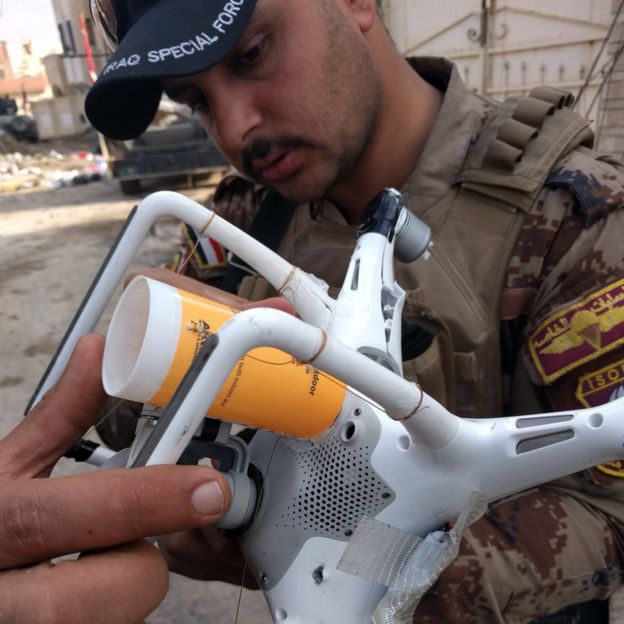
Basic cup holding mechanism on captured drone. (Credit: Mitch Utterback)
This appears to be supported by this video, which reportedly shows an Iraqi PMU capturing one of these modified drones, and one of its members holding a 40mm grenade that the drone was armed with.
IS released a propaganda video (Video 1) in January 2017 which contained multiple drone strikes. Notable amongst these is a flying-wing type UAV, reported to be an 8X Skywalker drone, which appears to carry two bombs at once in an under-wing configuration. These appear to be released simultaneously in the video. It should be noted that the forward movement of this kind of UAV makes it a poor platform for dropping munitions accurately, and it appears that every operational strike portrayed in Video 1 was in fact from a hovering drone of some kind.
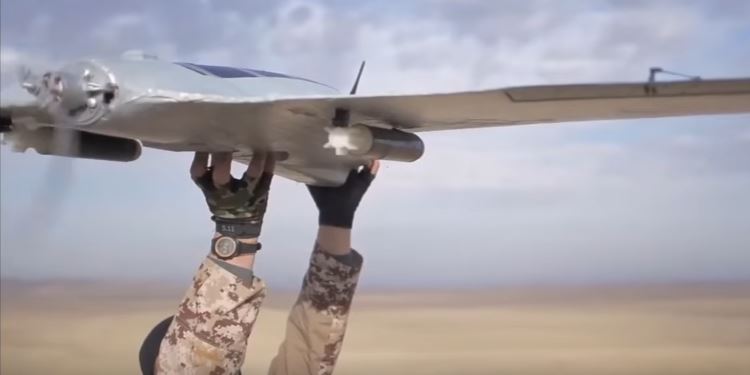
8X Skywalker drone with x2 bombs under-slung on the wings
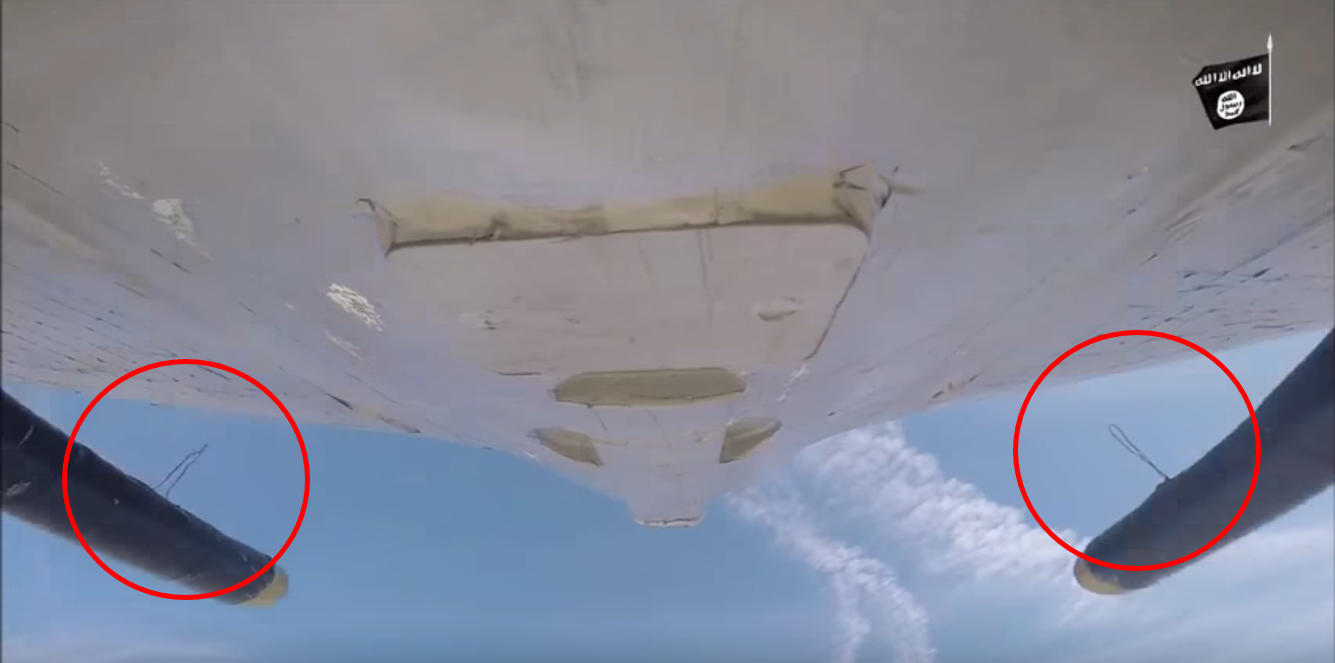
Dual release of munitions. Note the wire loops on the side of the bomb highlighted in red.
This kind of wire loop seen on the bombs above is also evident on the base of some other drone bombs, as can be seen in this still from the same video, suggesting a similar release mechanism:
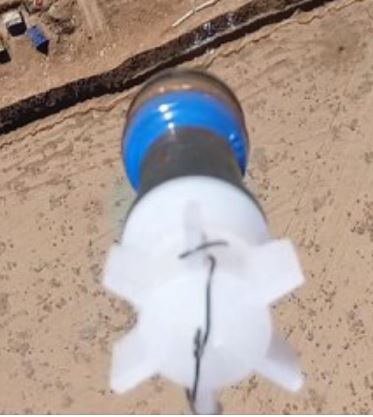
Note that the wire loop is on the base of this bomb, which was dropped from a hovering drone (Source)
Munitions in Video 1
The below examples are still images of munitions from Video 1. It depicts 20 drone strikes which cause multiple casualties with often surprising accuracy, dropping bombs on to tanks, or even into vehicles through their top-hatches. Even considering that many other unsuccessful strikes would not have been included in the video, this indicates that IS have the capability to drop a small bomb with surprising accuracy anywhere within the range of their drones.

Bomb 1 – Seen on the X8 Skywalker UAV. Appears to be a 40mm grenade warhead with some kind of extension and tail

Bomb 2 – Note the two fawn coloured bands highlighted by yellow arrows. These appear to be copper driving bands. Usually each round only has a single driving band, so the existence of two, with what appears to be tape between them, potentially indicates two rounds taped together

Bomb 3 – Appears to be a 40mm warhead with tail

Bomb 4 – Appears to be 40mm warhead with tail, possibly High Explosive Dual Purpose (HEDP)

Bomb 5 – Appears to be a 40mm, no tail. Possibly also has x2 driving bands

Bomb 6 – Appears to be a 40mm warhead with tail

Bomb 7 – Unidentified munition with streamer tail

Bomb 8 – Appears to be a 40mm warhead with tail

Bomb 9 – Unidentified munition with streamer tail. Low quality makes identification difficult

Bomb 10 – Appears to be a 40mm warhead with a tail
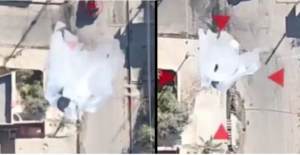
Bomb 11 – Unidentified munition with streamer tail. Image shows two different shots of the same bomb

Bomb 12 – Appears to be a 40mm warhead with tail

Bomb 13 – Appears to be a 40mm warhead with streamer tail

Bomb 14 – Appears to be a 40mm warhead with tail. Black band near tip appears to be tape

Bomb 15 – Appears to be 40mm warhead with tail

Bomb 16 – Appears to be 40mm warhead with tail. Note the use of tape

Bomb 17 – Appears to be 40mm warhead with tail. Note the similar use of tape to No. 16

Bomb 18 – Appears to be 40mm warhead with tail. Note the same use of tape as No.16 & 17
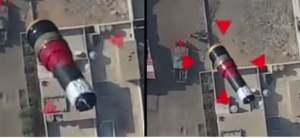
Bomb 19 – Appears to show a 40mm round which clearly shows some kind of extension strapped to its base

Bomb 20 – Appears to be 40mm warhead with tail. Note the use of tape seen previously
Examining Video 1 and other open sources we can see that several different types of munitions appear to be dropped from drones by IS. The manner in which they are deployed raises questions about exactly what kind of munitions they are. Superficially many look like 40mm grenades, either x53mm or x46mm, yet these kinds of grenades are armed (as opposed to detonated) both by the spin imparted by the barrel of the launcher, and the acceleration of being launched. None of the munitions seen in Video 1 appear to spin, and it is doubtful that the acceleration from being dropped would achieve the force necessary to arm such a round. The fins seen on many of the bombs are, as we will see later, straight, and will not impart spin.
Many of the 40mm rounds appear to be modified in some way. The appearance of bomb No. 2, with its two copper driving bands, even suggests that two 40mm rounds may have been connected together. Many have something connected to the base of the 40mm round which is not simply a tail, but rather appears to be thinner and longer than the round itself. Bomb No.19 shows this mostly clearly, although many of the bombs with tails also have this feature between the warhead and the tail section. This intermediate section may be a design feature to overcome the issues identified with arming a 40mm round, although this is an educated guess. The image below from another source clearly shows this intermediate section.
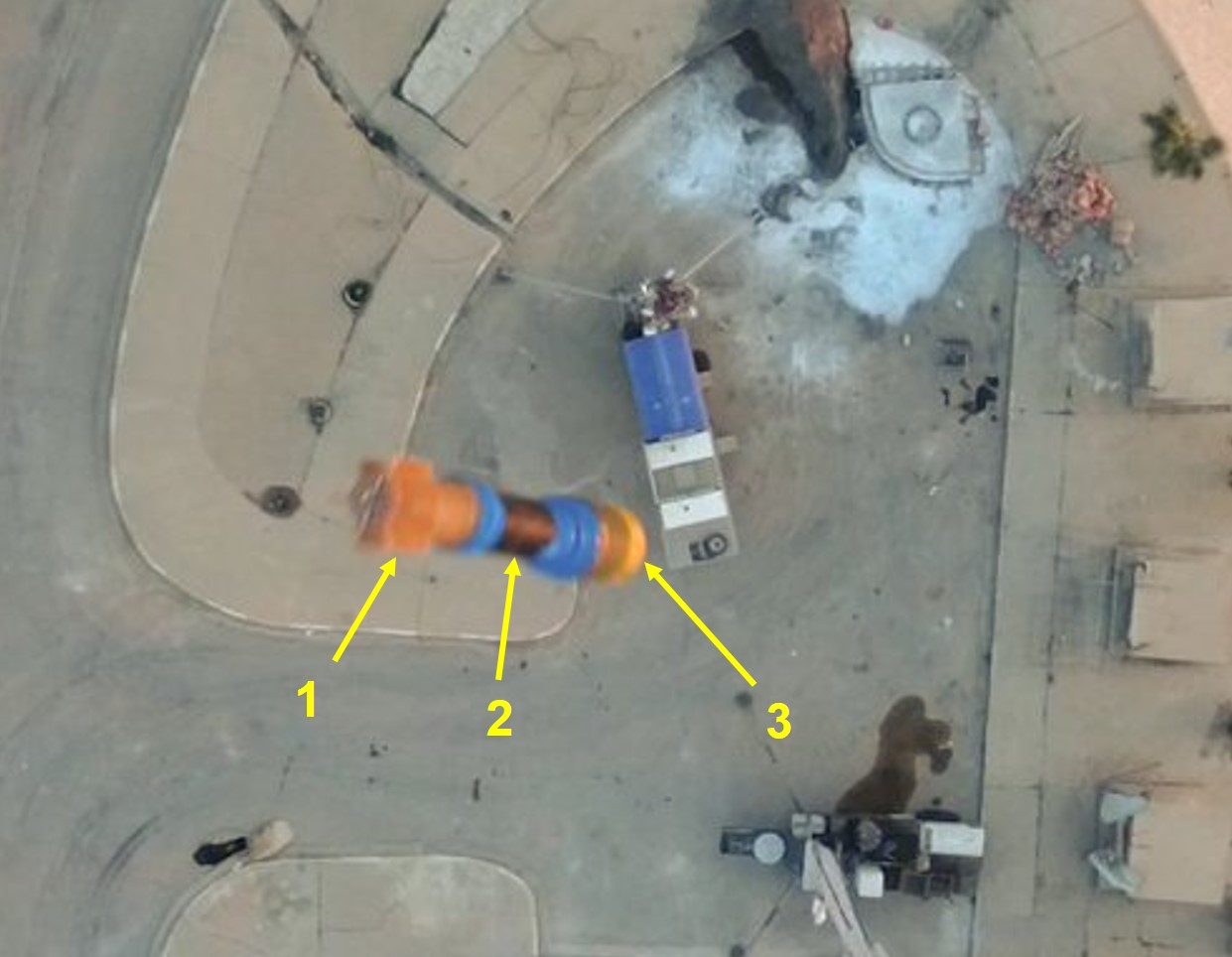
1. Tail, 2. Intermediate section, 3. 40mm warhead (Source)
Munitions in Other Media
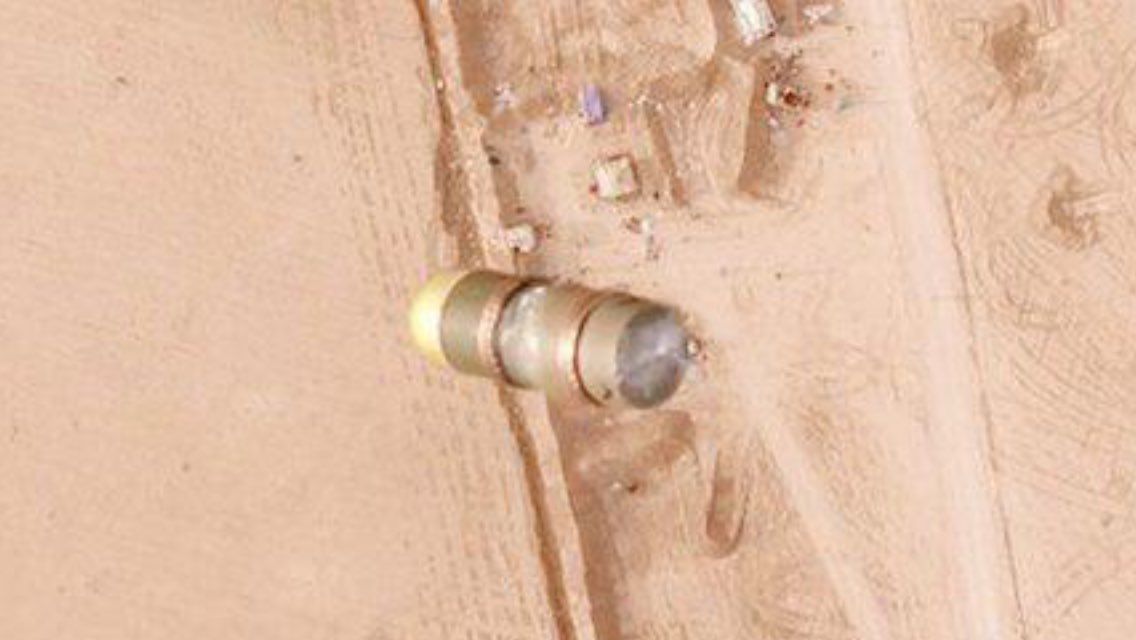
Bare 40mm. No tail (source)
This munition is notable for several reasons. Although it superficially appears to be a 40mm HEDP round, as with bomb No.19 we see that there are two copper driving bands present, a feature not seen on any other conventional 40mm rounds. It also appears to be lacking any kind of tail or intermediate section.
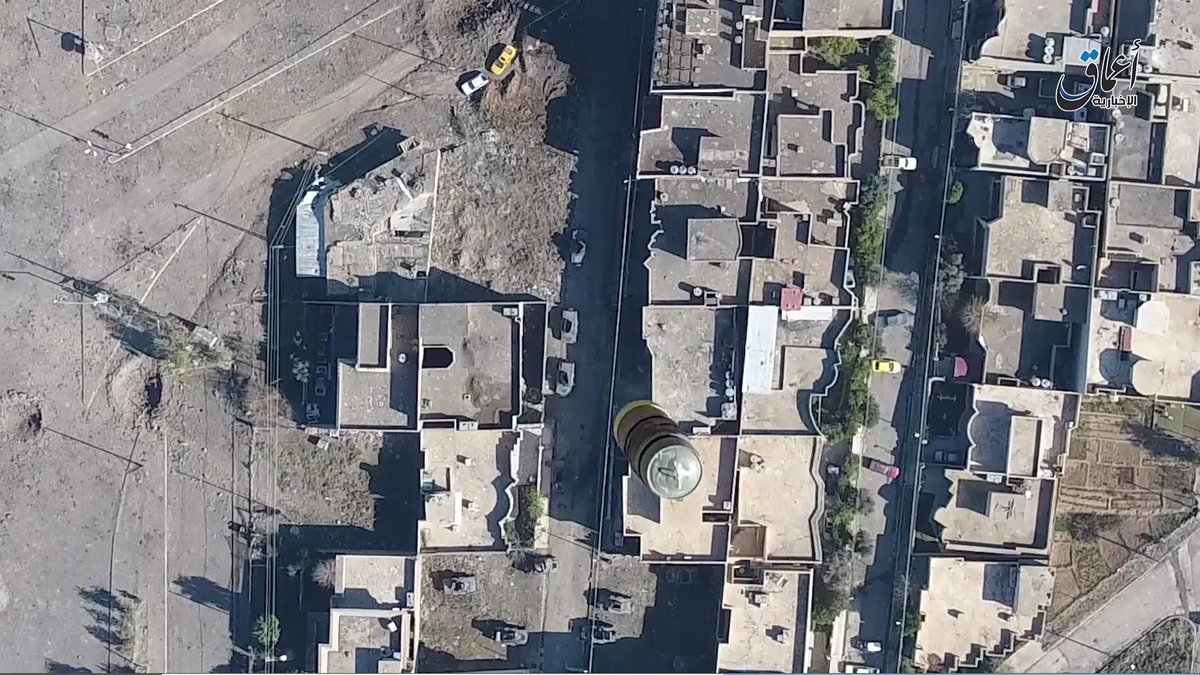
Bare 40mm bomb (source)
As in the image above, this bomb appears to have two driving bands and no tail. It is notable that there also appears to be a wire loop attached to the base of it.
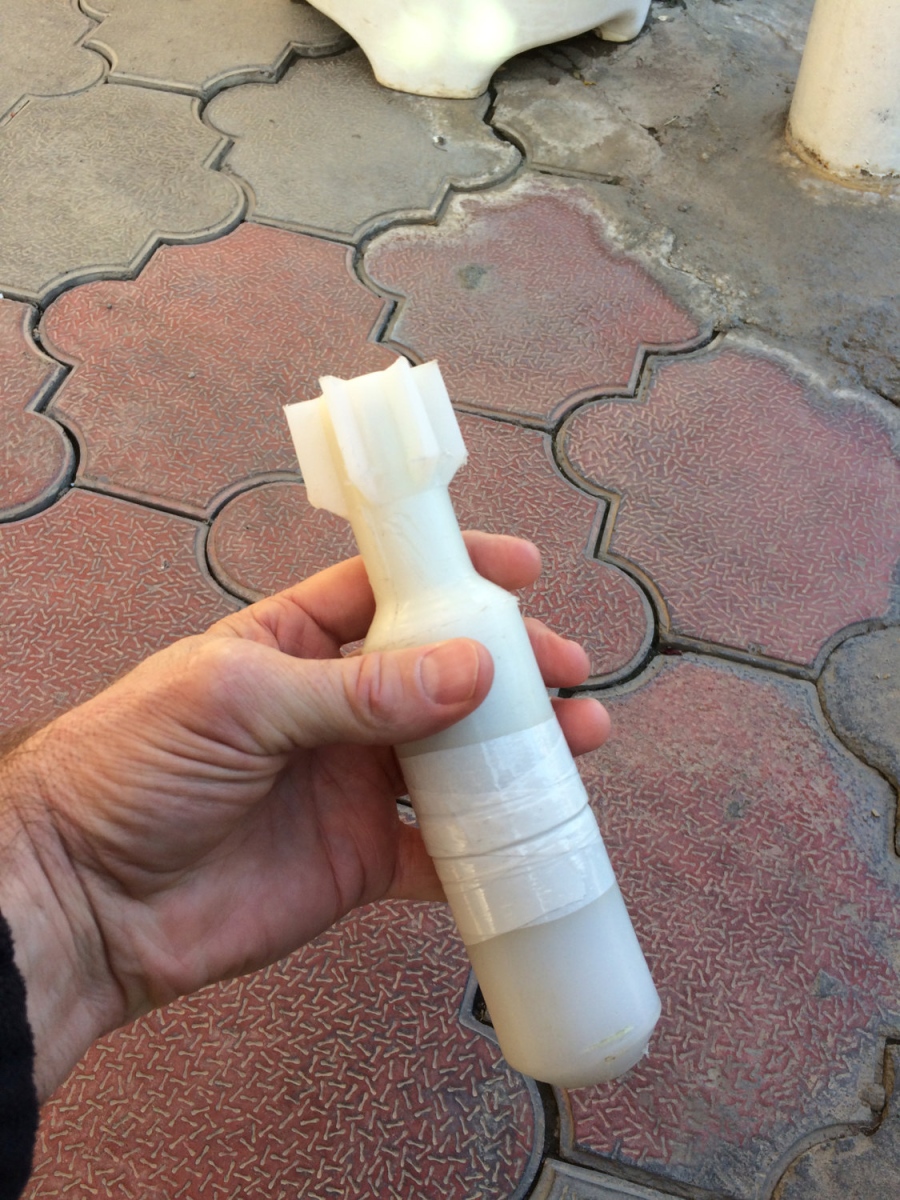
Possible practice bomb (Credit: Seth Robson)
This clearly shows a plastic round, seemingly without any kind of warhead attached to it. Considering that the skill required to accurately drop a small bomb probably requires training and practice, it seems likely this could be some kind of inert practice round.
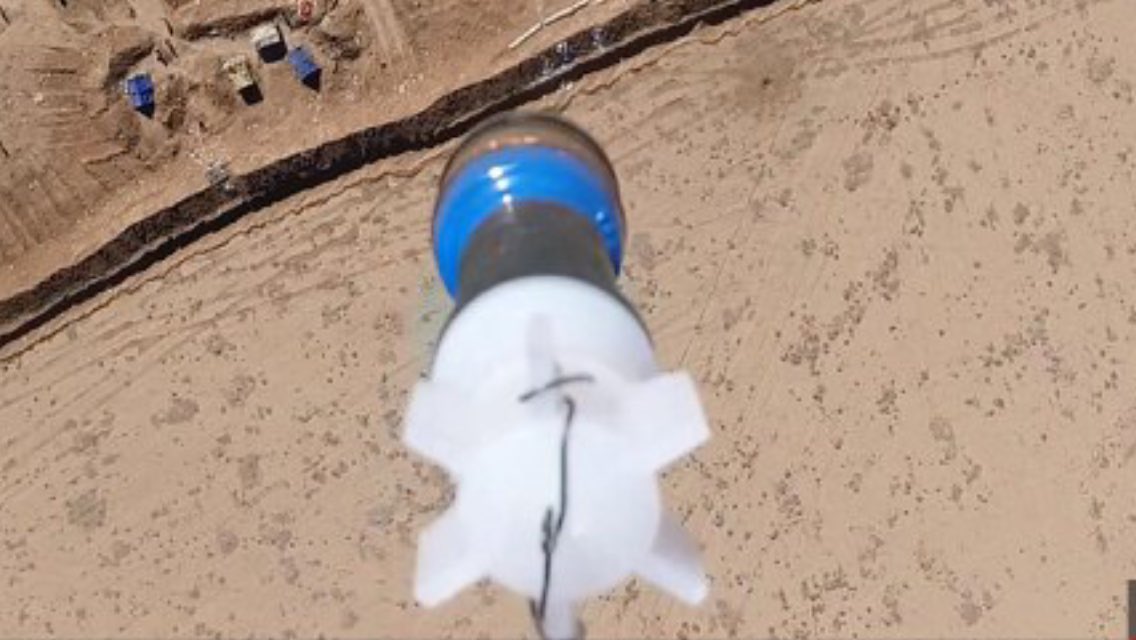
Blue tape bomb with wire (source)
This image, which we saw earlier, again shows a warhead attached by blue tape to some kind of intermediate section which fits into the white plastic tailfin. The wire on the base of the tail is also notable, as most other bombs do not appear to have this feature.

Unidentified munition (source)
This munition is unidentified and probably unidentifiable. It has been included for interest.
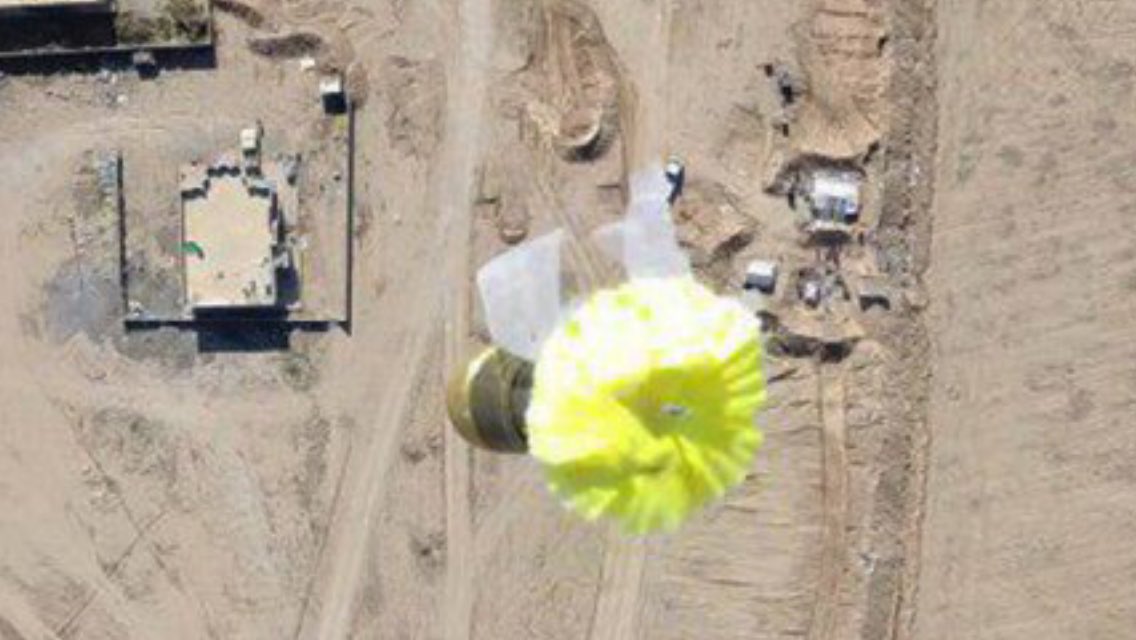
40mm round with parachute (source)
Here we see what appears to be an experiment with some kind of retarding parachute attached to a 40mm round. It appears to be unique.
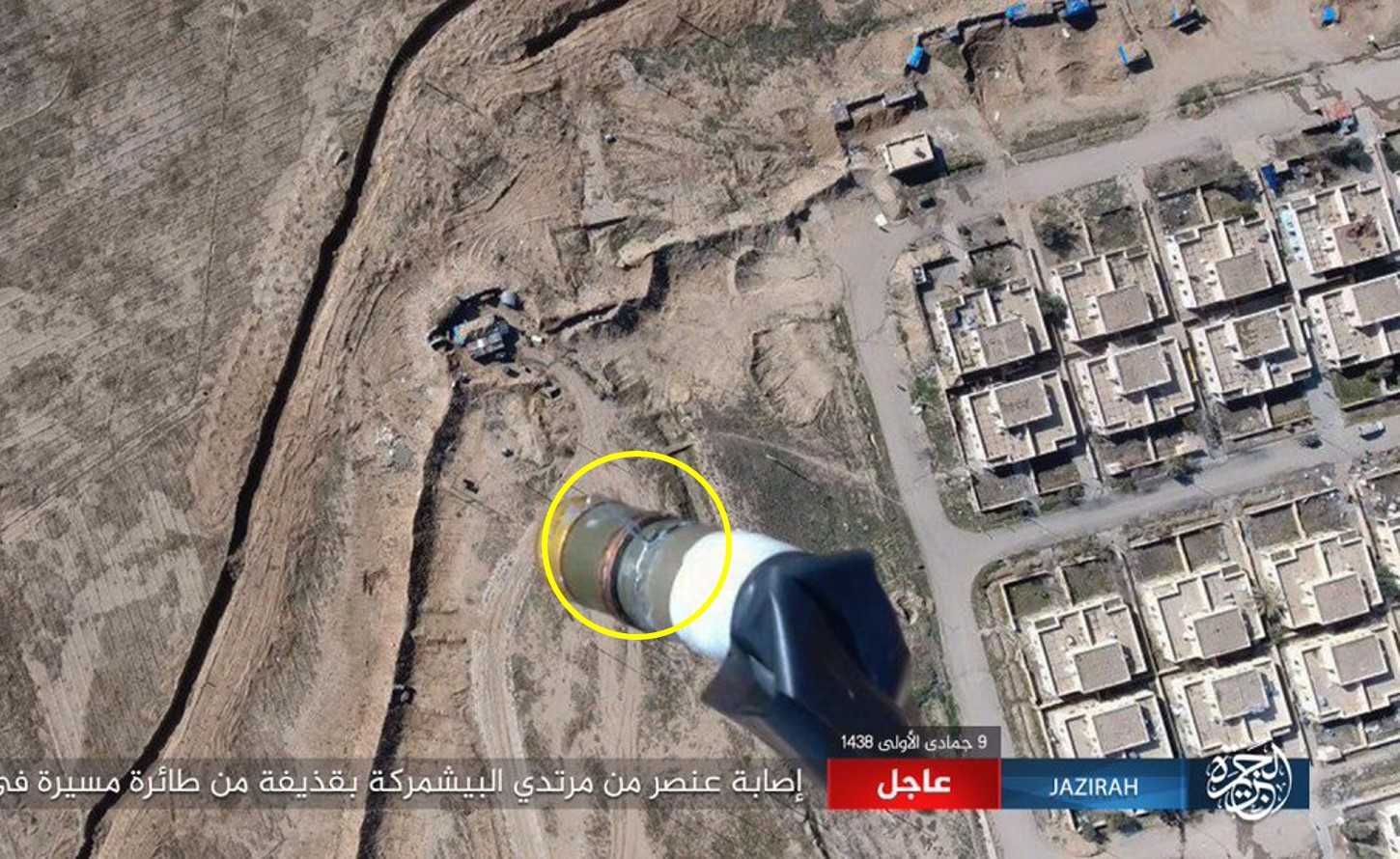
40mm round with streamer and side wire (Source)
Note the wire loop on the side highlighted in the yellow circle rather than the rear, suggesting that this bomb may have been released in a similar manner to those seen released by the X8 Skywalker seen in Video 1.
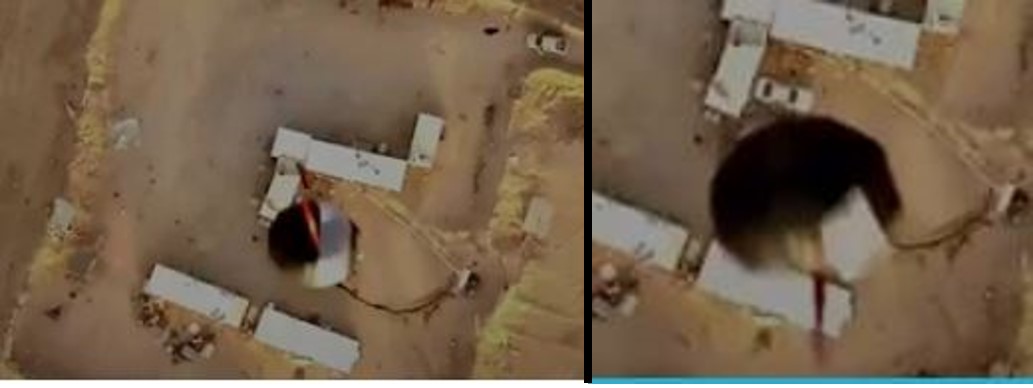
Ball Bomb – two different shots of the same bomb
This image, reportedly from IS’s operations in Anbar, Iraq show’s a munition that is much more ball-like, with either a red wire, or possibly a fuse extending from the main body.
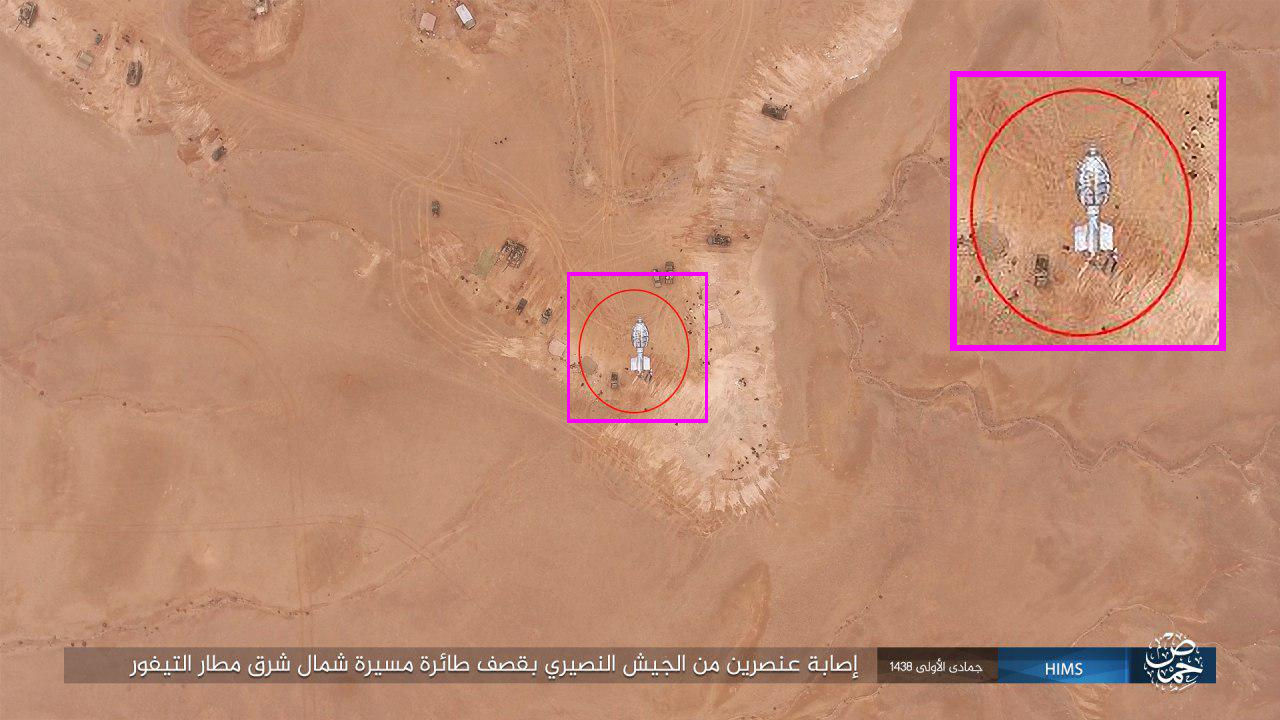
This image is from a reported IS attack in East Homs (source)
Note that the bomb appears to be a hand grenade with fins attached to the base, indicating that 40mm rounds are certainly not the only munitions being modified.
Suspected Drone Munitions
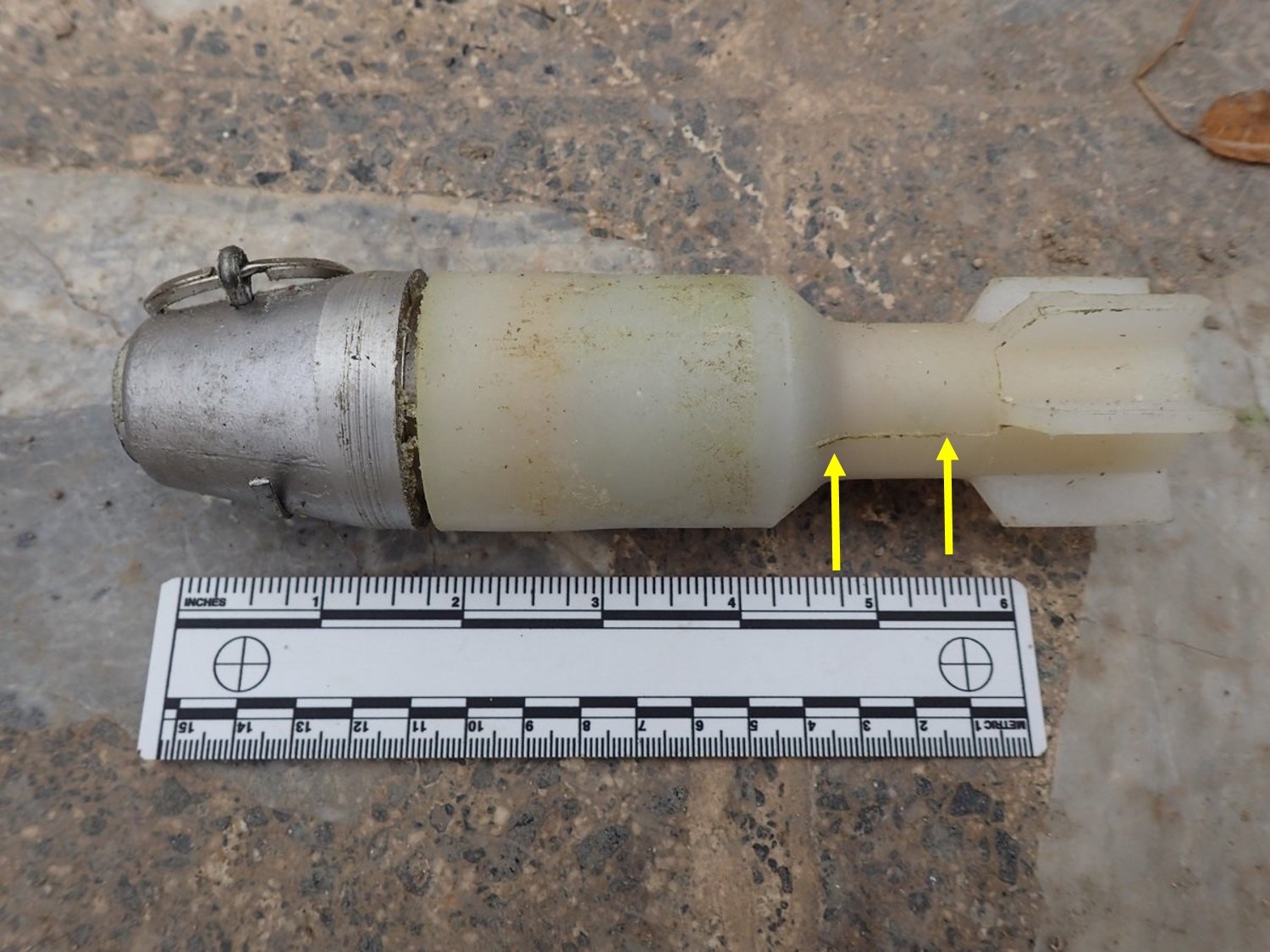
Single bomb with ruler (source)
This image very clearly shows the fins that we have seen connected to many of the other bombs so far. The seam on the stem indicated by the yellow arrows indicates that it was manufactured using injection moulding, not 3D printing as some have suggested. The large number seen in IS propaganda and captured by anti-IS forces supports this theory and indicates that these tail-fins are being produced using an inexpensive technique in industrial quantities.
The warhead also gives us some clues to work with. It appears to have a spigot base which slots into the tail-fin section. The construction of the warhead is also strange. Superficially it looks like a VOG 30 fuze, but appears to be too large, possibly making it some kind of mortar fuze. Its manufacturing quality also appears to be low, suggesting this may in fact be some kind of munition specially made by IS. This article by The Wall Street Journal based on an excellent report by Conflict Armament Research, reveals that these are in fact fuzes manufactured by IS for mortars. There is even a photo demonstrating that they are approximately 46mm wide.
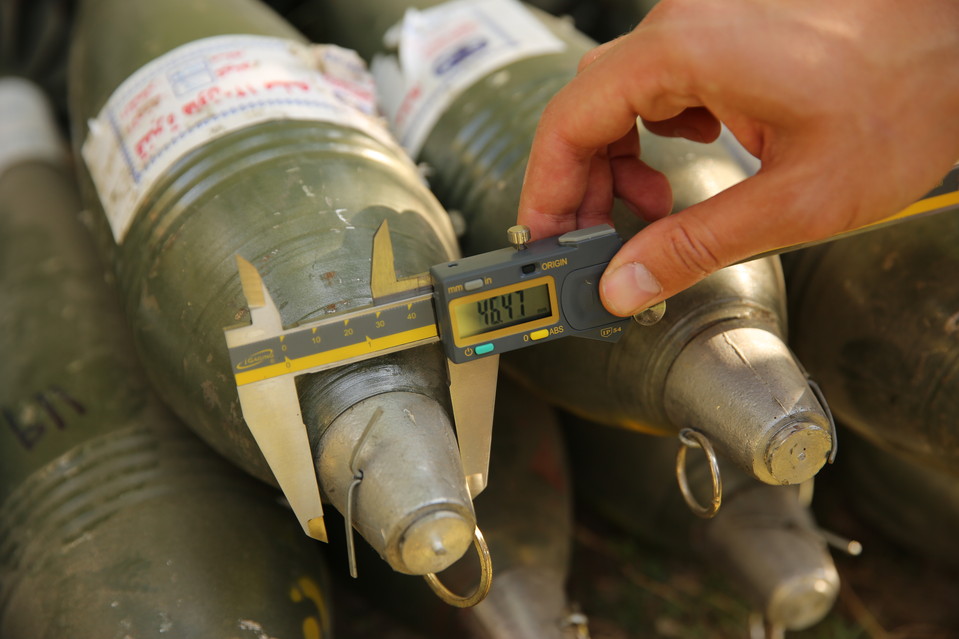
Note the basic safety pin (Credit: Conflict Armament Research (CAR))
Strangely there doesn’t seem to be any media showing these kinds of rounds being dropped by drones. These tailfins have evidently been produced in large quantities, as they are frequently seen in IS media, and advancing Iraqi forces appear to capture them in large batches.
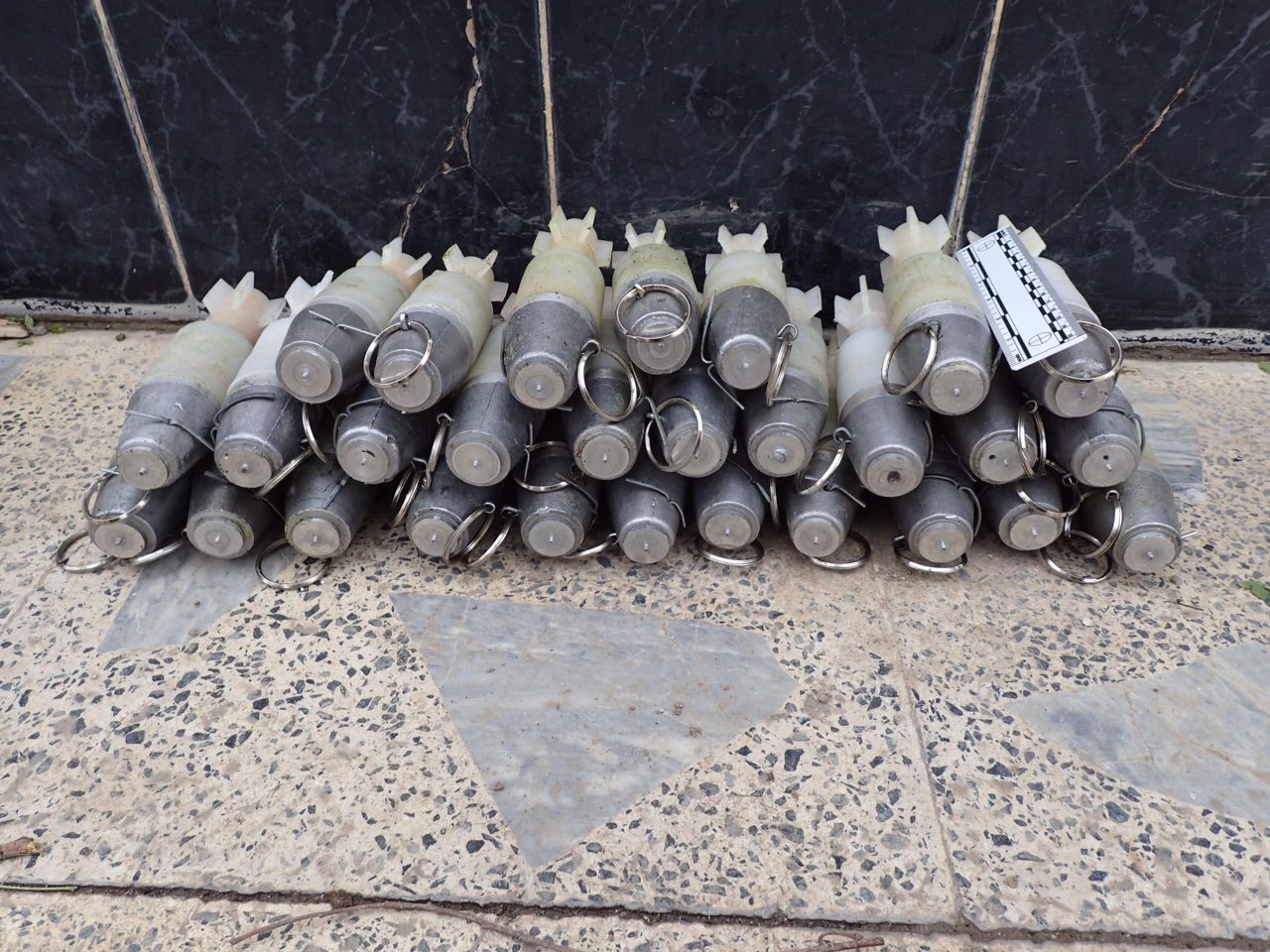
Multiple bombs. Note that the tips of the fuzes are identical to those shown in the earlier image from CAR. From this angle we can clearly see that the fins are straight (source)
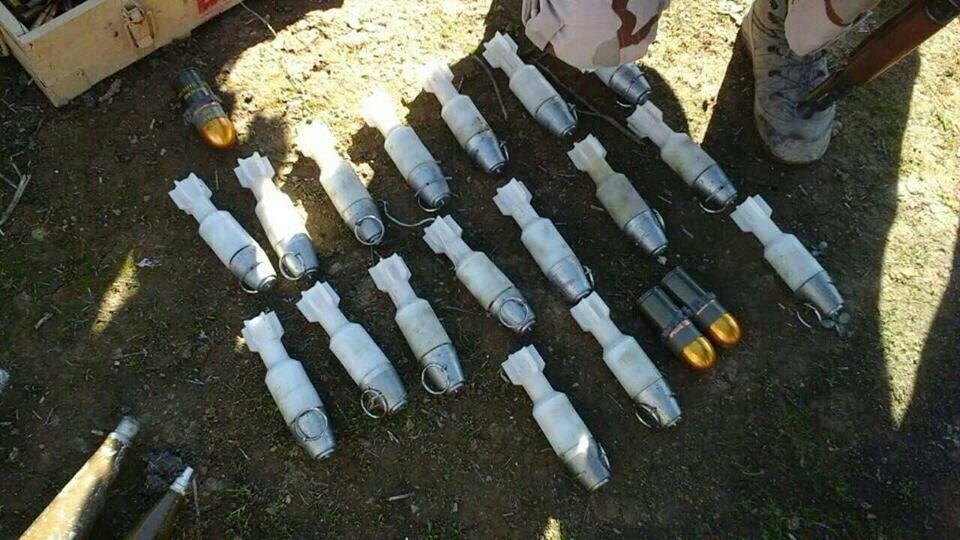
This image helpfully shows these bombs in comparison with 40mm grenades. (source)
Discussion
These videos and still images suggest a large-scale weaponised drone programme which has been testing and experimenting with a wide array of different munitions and modifications. This tallies with and supports other reports such as Combating Terrorism Center’s examination of ISIS’s drone program. With minor modifications commercial drones can be produced in large numbers to drop specialised ammunition. Existing munitions such as 40mm grenades are being modified, and entirely new kinds of standardised munitions, such as the 46mm fuze, are being manufactured by IS to fill this role. These modifications enable IS to drop theses munitions from drones, often with surprising accuracy, at heights of up to several hundred, possibly even 1000, feet. The white tail-fin sections appear to be industrially produced and have been seen with increasing regularity.
Compared to, for example, suicide vehicle-borne improvised explosive devices (SVBIEDs), these weapon systems have a relatively small physical effect on target. However, they do transform the battlespace from 2D to 3D, giving IS the capability to drop a small bomb, without warning and with surprising accuracy, at a place of their choosing. IS has used these kinds of drones to directly influence the tactical situation on the ground: in this extract from Video 1 we see that a drone strike was used to distract soldiers on the ground from the greater danger of the approaching SVBIED, which detonates with deadly effect.
This kind of capability has the potential to have a significant effect on the soldiers fighting IS on the ground, who must now be fully aware of the air as well as ground threat. However, anti-IS forces are certainly aware of this threat, and anti-drone weapons are starting to be seen in theatre. The modifications we have documented do not appear to be particularly advanced or difficult to achieve, although IS does appear to be adept at producing their own weapons and munitions. This demonstrates that the proliferation of small, armed drones is not a futuristic problem, but rather has simply become another part of the modern battlefield.
With thanks to Abraxas Spa, Veli-Pekka Kivimäki and PurpleOlive for help with analysis and sources.

